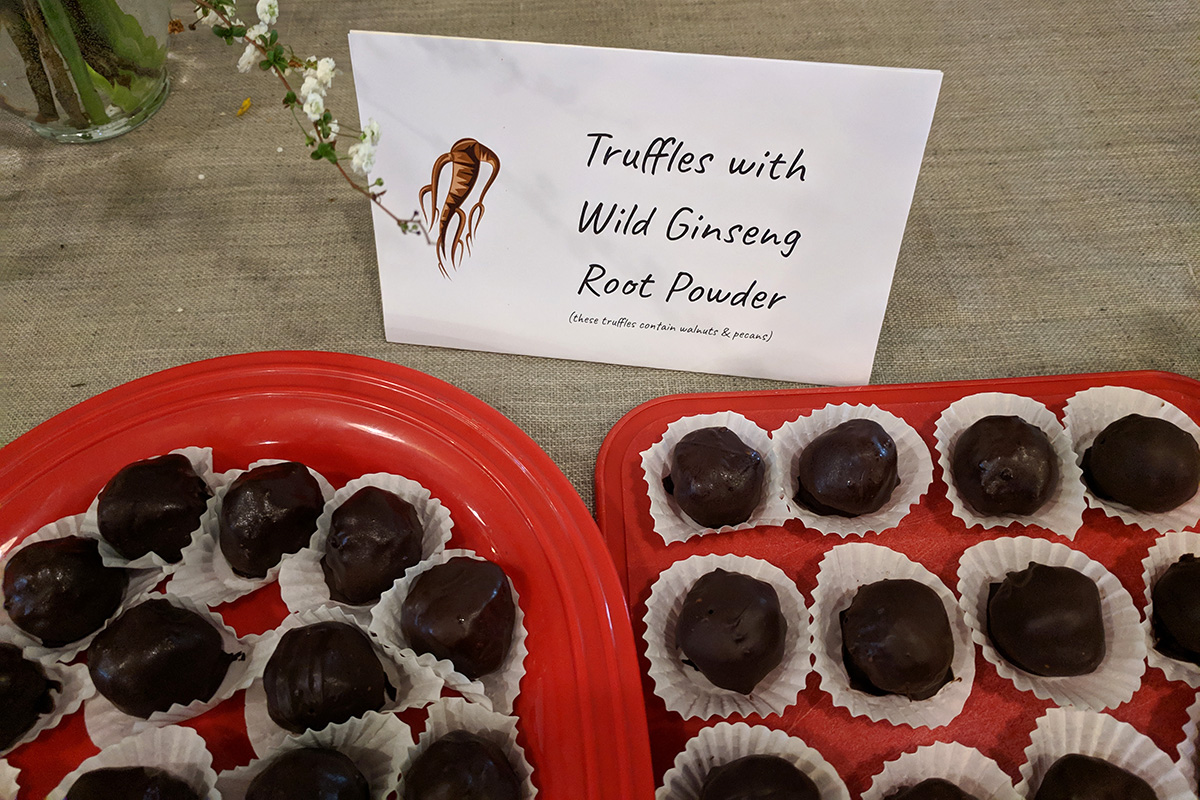Editor’s note: The fascinating history of American ginseng and the many people involved in its current cultivation, harvest, trade, medicinal use, and conservation are the subject of a proposed program for the 2020 Smithsonian Folklife Festival. Watch for more articles shedding light on this native plant in the coming months.
“One ounce of wild ginseng powder has the value of $150! I thought, ‘If I screw these up, Robert’s going to be so mad at me.’”
Luckily, Jess Larson did not screw them up. At a gathering of the North Carolina Ginseng Association at Warren Wilson College in March, she presented a beautiful tray of glistening dark chocolate ginseng truffles, made with the precious powder donated by association president Robert Eidus. As the group’s secretary and also a skilled confectioner, Larson was charged with incorporating ginseng leaves and roots into tasty treats for the meeting.
The table laden with these delights was understandably the most popular place in the room, which also displayed ginseng roots, ginseng-infused honey, and other products for a silent auction. A diverse range of experts shared their experiences: Caleb Trivett, who began digging ginseng with his family as a child; John Kim, a Korean American ginseng trader who is attempting to open new markets for fresh ginseng in Los Angeles; and Iris Gao, a scientist from Middle Tennessee University whose cutting-edge research should help speed up ginseng growth and determine new medical uses of both the roots and leaves.

Compared to the panel speakers, Larson admitted that she is a mere ginseng novice. She grows a variety of other herbs, and now she is trying her hand at ginseng in the shady woods at her home in Hickory, North Carolina. She likes to experiment with recipes including teas and tinctures, and now that she has tackled ginseng sweets, she wants to try her hand at ginseng-infused liquors and bitters.
Ginseng root powder is believed to increase your energy level and boost your immune system. The taste of ginseng root is described as earthy and slightly sweet by some, and bitter by others. To me, it added an interesting undertone of flavor to Larson’s rich chocolate truffles. And, whether from the root powder, the sugar, the chocolate, or the good company of ginseng enthusiasts, my energy soared all afternoon. Between all the experts and one expert confectioner, their talents and innovative ideas bode well for the future of American ginseng.
Try your hand at ginseng truffles with the recipe kindly shared by Jess Larson. You can purchase American ginseng powder online or at health food stores.
Chocolate Ginseng Truffles
Makes about 14 (adapted from Minimalist Baker)
Ingredients
1 cup raw pecans
1 cup raw walnuts
10 whole medjool dates, pitted (if dried out, soak in warm water for 10 minutes, then drain)
1 tablespoon cacao powder or unsweetened cocoa powder
1/2 teaspoon ground cinnamon (optional)
1 tablespoon ginseng root powder (more or less depending on how much ginseng you want to taste)
1 1/4 cups dairy-free dark chocolate, roughly chopped
1 teaspoon coconut oil
Toppings (optional)
1/4 cup cacao nibs, crushed pecans/walnuts
1/4 teaspoon sea salt
Directions
- Grind pecans and walnuts in a food processor or high-speed blender until they reach the consistency of a meal. Remove and set aside in a dish.
- Grind pitted dates in the food processor until small bits remain and/or it forms into a ball.
- Add the cocoa powder, cinnamon, ginseng powder, and half of the nut meal to the dates and pulse. Continue pulsing and adding the nut meal a little at a time until a loose dough is formed. You may not need to use all of the nuts, which is fine because you can use any leftovers for topping the truffles.
- Once you have a dough that’s easy to form into balls, scoop out one tablespoon and carefully roll or shape them into balls. (If they aren’t quite forming, hold the dough in your palm and let the heat of your hand warm them, then gently shape into a loose ball.) Set on parchment paper and place in freezer to chill while you prepare the chocolate.
- Melt chopped chocolate in a double boiler or in the microwave in 30-second increments. Be careful not to overheat. Once melted, remove from heat and stir in coconut oil to help the chocolate thin and ease the dipping process.
- Remove the truffles from freezer and, one at a time, dip them into the melted chocolate. Use a fork to remove them and tap away excess chocolate. Transfer back onto parchment paper and top with sea salt, crushed pecans, or cacao nibs before the chocolate hardens.
- Let set at room temperature. Store leftovers in an airtight container at room temperature. Transfer to freezer for longer-term storage.

Betty Belanus is a curator and education specialist at the Center for Folklife and Cultural Heritage. She is delving into the history and traditions of American ginseng as the subject of a Smithsonian Folklife Festival program for 2020.


